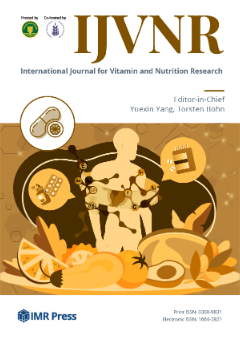International Journal for Vitamin and Nutrition Research (IJVNR) is published by IMR Press from Volume 95 Issue 1 (2025). Previous articles were published by another publisher under a hybrid publishing model, and they are hosted by IMR Press on imrpress.com as a courtesy and upon agreement with Hogrefe.
Effects of dietary nitrate and vitamin C co-ingestion on blood pressure and hand-grip strength in young adults
Background: Co-administration of vitamin C and inorganic nitrate ( ) may reduce oxidative stress, boost the conversion of nitrite (
) may reduce oxidative stress, boost the conversion of nitrite ( ) into NO and elicit positive vascular effects. Aims: We aimed to test the effects of oral inorganic
) into NO and elicit positive vascular effects. Aims: We aimed to test the effects of oral inorganic  and vitamin C co-supplementation on vascular function, muscular strength, and on concentrations of urinary
and vitamin C co-supplementation on vascular function, muscular strength, and on concentrations of urinary  , vitamin C, 8-isoprostanes and salivary
, vitamin C, 8-isoprostanes and salivary  in healthy young adults. Methods: Ten young healthy participants were enrolled in a randomised, double-blind (only for the
in healthy young adults. Methods: Ten young healthy participants were enrolled in a randomised, double-blind (only for the  intervention) crossover clinical trial. Participants consumed in random order: 1) nitrate-rich beetroot juice and vitamin C (N+VC), 2) nitrate-rich beetroot juice alone (N) or 3) nitrate-depleted beetroot juice alone (ND). Resting blood pressure (BP) was measured at the research centre and at home. Non-invasive, continuous measurements of BP and cardiac function parameters were performed using a Finometer device. Free-living physical activity and hand-grip strength were assessed. Salivary
intervention) crossover clinical trial. Participants consumed in random order: 1) nitrate-rich beetroot juice and vitamin C (N+VC), 2) nitrate-rich beetroot juice alone (N) or 3) nitrate-depleted beetroot juice alone (ND). Resting blood pressure (BP) was measured at the research centre and at home. Non-invasive, continuous measurements of BP and cardiac function parameters were performed using a Finometer device. Free-living physical activity and hand-grip strength were assessed. Salivary  and
and  and urinary
and urinary  , 8-isoprostanes and vitamin C concentrations were measured. Results: There were no significant differences for any of the vascular outcomes between the three interventions groups. However, analyses of within-intervention changes showed a significant lower daily systolic BP in the
, 8-isoprostanes and vitamin C concentrations were measured. Results: There were no significant differences for any of the vascular outcomes between the three interventions groups. However, analyses of within-intervention changes showed a significant lower daily systolic BP in the  +vitamin C (N+VC) group only (P=0.04). Urinary
+vitamin C (N+VC) group only (P=0.04). Urinary  (P=0.002) and salivary
(P=0.002) and salivary  (P=0.001) were significantly higher in the N+VC group compared to the N and ND groups. Conclusion: These preliminary findings suggest that combining dietary
(P=0.001) were significantly higher in the N+VC group compared to the N and ND groups. Conclusion: These preliminary findings suggest that combining dietary  with vitamin C could have protective effects on vascular function in young adults and could represent an effective strategy for the maintenance of healthy cardiovascular trajectories.
with vitamin C could have protective effects on vascular function in young adults and could represent an effective strategy for the maintenance of healthy cardiovascular trajectories.

